Administration of Vaccines in Dairy Sheep and Goat Farms: Patterns of Vaccination, Associations with Health and Production Parameters, Predictors
Abstract
:1. Introduction
2. Materials and Methods
2.1. Small Ruminant Farms and Interviews of Farmers
2.2. Milk Samples and Laboratory Examinations
2.3. Data Management and Analysis
3. Results
3.1. Descriptive Findings and Programs of Vaccinations in the Farms
3.2. Associations with Parameters Related to Health and Production in the Farms
3.3. Predictors
3.4. Total Number of Vaccinations Performed in Farms
4. Discussion
4.1. Preamble
4.2. Vaccination Patterns
4.3. Associations with Health and Production in the Farms
4.4. Factors Associated with the Vaccinations
5. Conclusions
Supplementary Materials
Author Contributions
Funding
Institutional Review Board Statement
Informed Consent Statement
Data Availability Statement
Conflicts of Interest
Appendix A
| Variables | Odds Ratio 1 (95% Confidence Intervals) | p Value |
|---|---|---|
| (a) Sheep flocks | ||
| Daily number of milking sessions | 0.002 | |
| One (0/1 = 0.0%) | 5.133 (0.201–131.421) | 0.32 |
| Two (92/ 264 = 34.8%) | 3.229 (1.803–5.785) | 0.0001 |
| Three (38/60 = 63.3%) | reference | - |
| Age of newborns when taken away from dam | 0.003 | |
| ≤40 days (63/117 = 53.8%) | reference | - |
| 41–60 days (61/172 = 35.5%) | 2.123 (1.315–3.428) | 0.002 |
| >6.5 days (6/36 = 16.7%) | 5.833 (2.258–15.067) | 0.0003 |
| (b) Goat herds | ||
| Average age of culling female animals | 0.001 | |
| ≤6.5 years (26/50 = 52.0%) | reference | - |
| >6.5 years (13/69 = 18.8%) | 4.667 (2.056–10.593) | 0.0002 |
| Daily period spent by farmer at the farm | 0.002 | |
| ≤8 h (5/28 = 17.9%) | 2.744 (0.954–7.890) | 0.06 |
| >8 h (34/91 = 37.4%) | reference | - |
| Daily number of milking sessions | 0.031 | |
| One (1/4 = 25.0%) | 18.000 (0.812–399.177) | 0.07 |
| Two (32/108 = 29.6%) | 14.500 (1.648–123.188) | 0.016 |
| Three (6/7 = 85.7%) | reference | - |
| Breed of animals in the farm | 0.032 | |
| Crossbreeds (7/18 = 38.9%) | 0.971 (0.326–2.895) | 0.957 |
| Imported breeds (21/45 = 46.7%) | reference | - |
| Local breeds (11/55 = 20.0%) | 2.471 (1.050–5.814) | 0.038 |
| Age of newborns when taken away from dam | 0.037 | |
| ≤40 days (15/26 = 57.7%) | reference | - |
| 41–60 days (12/44 = 27.3%) | 3.636 (1.308–10.110) | 0.013 |
| >60 days (12/49 = 24.5%) | 4.205 (1.524–11.597) | 0.006 |
| Variables | Odds Ratio 1 (95% Confidence Intervals) | p Value |
|---|---|---|
| (a) Sheep flocks | ||
| Management system applied in the farm | 0.003 | |
| Intensive (44/44 = 100.0%) | reference | - |
| Semi-intensive (138/140 = 95.0%) | 1.607 (0.076–34.097) | 0.76 |
| Semi-extensive (112/116 = 96.6%) | 3.560 (0.188–67.498) | 0.40 |
| Extensive (22/25 = 88.0%) | 13.844 (0.685–279.832) | 0.09 |
| Family tradition in farming | 0.006 | |
| Yes (277/283 = 97.9%) | reference | - |
| No (39/42 = 92.9%) | 4.735 (0.767–29.234) | 0.09 |
| Age of farmers | 0.024 | |
| ≤50 years (195/197 = 99.0%) | reference | - |
| >50 years (121/128 = 94.5%) | 0.460 (0.094–2.253) | 0.34 |
| (b) Goat herds | ||
| Family tradition in farming | 0.006 | |
| Yes (103/103 = 100.0%) | reference | - |
| No (15/16 = 93.8%) | 20.032 (0.781–513.999) | 0.07 |
| Variables | Odds Ratio 1 (95% Confidence Intervals) | p Value |
|---|---|---|
| (a) Sheep flocks | ||
| Management system applied in the farm | 0.0004 | |
| Intensive (36/44 = 81.8%) | reference | - |
| Semi-intensive (89/140 = 63.6%) | 2.579 (1.113–5.972) | 0.027 |
| Semi-extensive (58/116 = 50.0%) | 4.500 (1.927–10.509) | 0.0005 |
| Extensive (3/25 = 12.0%) | 33.000 (7.905–137.760) | <0.0001 |
| Duration of dry period | 0.013 | |
| ≤2 months (77/107 = 72.0%) | reference | - |
| >2 months (109/218 = 50.0%) | 2.567 (1.559–4.225) | 0.0002 |
| Collaboration with a veterinarian | 0.032 | |
| Yes (173/283 = 61.1%) | reference | - |
| No (13/42 = 31.0%) | 3.508 (1.748–7.040) | 0.0004 |
| (b) Goat herds | ||
| Use of laboratory diagnostic examinations in samples of milk | 0.009 | |
| Yes (22/25 = 88.0%) | reference | - |
| No (43/94 = 45.7%) | 8.698 (2.436–31.056) | 0.0009 |
| Collaboration with a veterinarian | 0.034 | |
| Yes (62/102 = 60.8%) | reference | - |
| No (3/17 = 17.6%) | 7.233 (1.954–26.776) | 0.003 |
| Variables | Odds Ratio 1 (95% Confidence Intervals) | p Value |
|---|---|---|
| (a) Sheep flocks | ||
| Average age of culling female animals | 0.041 | |
| ≤6.5 years (1/242 = 0.4%) | 5.951 (0.533–66.497) | 0.15 |
| >6.5 years (2/83 = 2.4%) | reference | - |
| Farmer’s general education | 0.047 | |
| Primary education (2/57 = 3.5%) | reference | - |
| Secondary or post-secondary education (1/225 = 0.4%) | 8.146 (0.725–91.470) | 0.09 |
| Tertiary education (0/43 = 0.0%) | 3.919 (0.183–83.769) | 0.38 |
| (b) Goat herds | ||
| No variables found with a significant association | ||
| Variable | Odds Ratio 1 (95% Confidence Intervals) | p Value |
|---|---|---|
| Farmer’s general education | 0.008 | |
| Primary education (0/57 = 0.0%) | 9.938 (0.500–197.708) | 0.13 |
| Secondary or post-secondary education (2/225 = 0.9%) | 8.363 (1.354–51.643) | 0.022 |
| Tertiary education (3/43 = 7.0%) | reference | - |
| Variables | Odds Ratio 1 (95% Confidence Intervals) | p Value |
|---|---|---|
| (a) Sheep flocks | ||
| No variables found with a significant association | ||
| (b) Goat herds | ||
| No. of female animals in the farm | 0.0009 | |
| ≤165 does (8/54 = 14.8%) | 6.708 (1.785–25.211) | 0.005 |
| 166–330 does (11/37 = 29.7%) | 2.758 (0.753–10.103) | 0.13 |
| 331–500 does (5/13 = 38.5%) | 1.867 (0.392–8.895) | 0.43 |
| >500 does (7/13 = 53.8%) | reference | - |
| Variables | Odds Ratio 1 (95% Confidence Intervals) | p Value |
|---|---|---|
| (a) Sheep flocks | ||
| Routine administration of antibiotics to newborns | 0.010 | |
| Yes (41/70 = 58.6%) | reference | - |
| No (103/255 = 40.4%) | 2.086 (1.219–3.571) | 0.007 |
| Daily period spent by farmer at the farm | 0.017 | |
| ≤8 h (34/99 = 34.3%) | 1.813 (1.111–2.959) | 0.017 |
| >8 h (110/226 = 48.7%) | reference | - |
| (b) Goat herds | ||
| No variables found with a significant association | ||
| Variables | Odds Ratio 1 (95% Confidence Intervals) | p Value |
|---|---|---|
| (a) Sheep flocks | ||
| Use of laboratory diagnostic examinations in samples of milk | 0.005 | |
| Yes (39/70 = 55.7%) | reference | - |
| No (87/255 = 34.1%) | 2.429 (1.419–4.161) | 0.001 |
| Collaboration with a veterinarian | 0.025 | |
| Yes (119/283 = 42.0%) | reference | - |
| No (7/42 = 16.7%) | 3.628 (1.558–8.447) | 0.003 |
| (b) Goat herds | ||
| Type of milking mode | 0.002 | |
| Machine-milking (27/66 = 40.9%) | reference | - |
| Hand-milking (7/53 = 13.2%) | 4.550 (1.787–11.581) | 0.002 |
| Daily period spent by farmer at the farm | 0.006 | |
| ≤8 h (5/28 = 17.9%) | 2.152 (0.743–6.228) | 0.16 |
| >8 h (29/91 = 31.9%) | reference | - |
| Daily number of milking sessions | 0.016 | |
| One (0/4 = 0.0%) | 19.800 (0.744–527.292) | 0.07 |
| Two (29/108 = 26.9%) | 6.810 (1.251–37.063) | 0.027 |
| Three (5/7 = 71.4%) | reference | - |
References
- Lacasta, D.; Ferrer, L.M.; Ramos, J.J.; González, J.M.; Ortín, A.; Fthenakis, G.C. Vaccination schedules in small ruminant farms. Vet. Microbiol. 2015, 181, 34–46. [Google Scholar] [CrossRef] [PubMed]
- Zhang, N.; Huang, D.S.; Wu, W.; Liu, J.; Liang, F.; Zhou, B.S.; Guan, P. Animal brucellosis control or eradication programs worldwide: A systematic review of experiences and lessons learned. Pr. Vet. Med. 2018, 160, 105–115. [Google Scholar] [CrossRef] [PubMed]
- Al Hamada, A.; Bruce, M.; Barnes, A.; Habib, I.; Robertson, I.D. Cost-benefit analysis of a mass vaccination strategy to control brucellosis in sheep and goats in Northern Iraq. Vaccines 2021, 9, 878. [Google Scholar] [CrossRef] [PubMed]
- Khatibi, M.; Abdulaliyev, G.; Azimov, A.; Ismailova, R.; Ibrahimov, S.; Shikhiyev, M.; Agalarov, D.; Seyidov, T.; Omarov, A.; Suleymanova, C.; et al. Working towards development of a sustainable brucellosis control programme, the Azerbaijan example. Res. Vet. Sci. 2021, 137, 252–261. [Google Scholar] [CrossRef] [PubMed]
- Blasco, J.M.; Molin-Flores, B. Control and eradication of Brucella melitensis in sheep and goats. Vet. Clin. N. Am. Food Anim. Pract. 2011, 27, 95–104. [Google Scholar] [CrossRef]
- Parida, S.; Muniraju, M.; Mahapatra, M.; Muthuchelvan, D.; Buczkowski, H.; Banyard, A.C. Peste des petits ruminants. Vet. Microbiol. 2015, 181, 90–106. [Google Scholar] [CrossRef]
- Jemberu, W.T.; Knight-Jones, T.J.D.; Gebru, A.; Mekonnen, S.A.; Yirga, A.; Sibhatu, D.; Rushton, J. Economic impact of a peste des petits ruminants outbreak and vaccination cost in northwest Ethiopia. Transbound. Emerg. Dis. 2022. [Google Scholar] [CrossRef]
- Fthenakis, G.C.; Calvo-Gonzalez Valerio, T. Recent advances in immunisation against mastitis in sheep. In Proceedings of the Conference Booklet of 9th International Sheep Veterinary Congress, Harrogate, UK, 22–26 May 2017; p. 62. [Google Scholar]
- Gonzalez, J.M.; Navarro, T.; Lacasta, D.; Ramos, J.J.; Ferrer, L.M.; Vasileiou, N.G.C.; de las Heras, M. Prevention of ovine respiratory complex in lambs based on vaccination. Small Rumin. Res. 2017, 180, 127–130. [Google Scholar] [CrossRef]
- Amores, J.; Sanchez, A.; Gomez-Martin, A.; Corrales, J.C.; Contreras, A.; de la Fe, C. Surveillance of Mycoplasma agalactiae and Mycoplasma mycoides subsp. capri in dairy goat herds. Small Rumin. Res. 2012, 102, 89–93. [Google Scholar] [CrossRef]
- Links, I.J.; Denholm, L.J.; Evers, M.; Kingham, L.J.; Greenstein, R.J. Is vaccination a viable method to control Johne’s disease caused by Mycobacterium avium subsp. paratuberculosis? Data from 12 million ovine vaccinations and 7.6 million carcass examinations in New South Wales, Australia from 1999–2009. PLoS ONE 2021, 16, e0246411. [Google Scholar] [CrossRef]
- Tizard, I.R. Vaccines for Veterinarians; Elsevier: Saint-Louis, MO, USA, 2021. [Google Scholar]
- Lewis, C.L. Vaccination of sheep—An update. Practice 2000, 22, 34–38. [Google Scholar] [CrossRef]
- Bennett, G.N.; Hickford, J.G.H. Ovine footrot: New approaches to an old disease. Vet. Microbiol. 2011, 148, 1–7. [Google Scholar] [CrossRef] [PubMed]
- Pulina, G.; Milán, M.J.; Lavín, M.P.; Theodoridis, A.; Morin, E.; Capote, J.; Thomas, D.L.; Francesconi, A.H.D.; Caja, G. Current production trends, farm structures, and economics of the dairy sheep and goat sectors. J. Dairy Sci. 2018, 101, 6715–6729. [Google Scholar] [CrossRef] [PubMed]
- Lianou, D.T.; Chatziprodromidou, I.P.; Vasileiou, N.G.C.; Michael, C.K.; Mavrogianni, V.S.; Politis, A.P.; Kordalis, N.G.; Billinis, C.; Giannakopoulos, A.; Papadopoulos, E.; et al. A detailed questionnaire for the evaluation of health management in dairy sheep and goats. Animals 2020, 10, 1489. [Google Scholar] [CrossRef]
- Barrow, G.I.; Feltham, R.K.A. Manual for the Identification of Medical Bacteria, 3rd ed.; Cambridge University Press: Cambridge, UK, 1993. [Google Scholar]
- Euzeby, J.P. List of bacterial names with standing in nomenclature: A folder available on the Internet. Int. J. Syst. Bacteriol. 1997, 47, 590–592. [Google Scholar] [CrossRef]
- Lianou, D.T.; Michael, C.K.; Vasileiou, N.G.C.; Petinaki, E.; Cripps, P.J.; Tsilipounidaki, K.; Katsafadou, A.I.; Politis, A.P.; Kordalis, N.G.; Ioannidi, K.S.; et al. Extensive countrywide field investigation of somatic cell counts and total bacterial counts in bulk-tank raw milk in sheep flocks in Greece. Foods 2021, 10, 268. [Google Scholar] [CrossRef]
- Lianou, D.T.; Michael, C.K.; Vasileiou, N.G.C.; Petinaki, E.; Cripps, P.J.; Tsilipounidaki, K.; Katsafadou, A.I.; Politis, A.P.; Kordalis, N.G.; Ioannidi, K.S.; et al. Extensive countrywide field investigation of somatic cell counts and total bacterial counts in bulk-tank raw milk in goat herds in Greece. J. Dairy Res. 2021, 88, 307–313. [Google Scholar] [CrossRef]
- Vasileiou, N.G.C.; Chatzopoulos, D.C.; Gougoulis, D.A.; Sarrou, S.; Katsafadou, A.I.; Spyrou, V.; Mavrogianni, V.S.; Petinaki, E.; Fthenakis, G.C. Slime-producing staphylococci as causal agents of subclinical mastitis in sheep. Vet. Microbiol. 2018, 224, 93–99. [Google Scholar] [CrossRef]
- Ministry of Agricultural Development & Food. Greek Agriculture—Animal Production; Ministry of Agricultural Development & Food, General Directorate for Animal Production: Athens, Greece, 2018; p. 16. [Google Scholar]
- Hadjigeorgiou, I.; Vallerand, F.; Tsimpoukas, K.; Zervas, G. The socio-economics of sheep and goat farming in Greece and the implications for future rural development. Opt. Méditerran. B Etud. Recherch. 2002, 39, 83–93. [Google Scholar]
- Hellenic Milk Board. Deliveries of Ovine and Caprine Milk by Region and Regional Authority and Average Milk Price—Calendar Year 2019. Available online: https://www.elgo.gr/images/ELOGAK_files/Statistics/2020/AIGO_Παραδόσεις_Πρόβειου_και_Γίδινου_Γάλακτος_2019.pdf (accessed on 12 January 2022).
- Ngai, E.W.T.; Wat, F.K.T. Human resource information systems: A review and empirical analysis. Person. Rev. 2006, 35, 297–314. [Google Scholar] [CrossRef]
- Dougas, G.; Katsiolis, A.; Linou, M.; Kostoulas, P.; Billinis, C. Modelling human brucellosis based on infection rate and vaccination coverage of sheep and goats. Pathogens 2022, 11, 167. [Google Scholar] [CrossRef] [PubMed]
- National Public Health Organization of Greece. Brucellosis. Available online: https://eody.gov.gr/disease/vroykellosi/ (accessed on 15 March 2022).
- Minas, A.; Stournara, A.; Tselepidis, S. The “effects” of Rev-1 vaccination of sheep and goats on human brucellosis in Greece. Pr. Vet. Med. 2004, 64, 41–47. [Google Scholar] [CrossRef] [PubMed]
- Jelastopulu, E.; Bikas, C.; Petropoulos, C.; Leotsinidis, M. Incidence of human brucellosis in a rural area in Western Greece after the implementation of a vaccination programme against animal brucellosis. BMC Public Health 2008, 8, 241. [Google Scholar] [CrossRef] [PubMed]
- Van Metre, D. Enterotoxemia (Overeating Disease) of Sheep and Goats; Fact Sheet No. 8018; Colorado State University Extension: Fort Collins, CO, USA, 2010. [Google Scholar]
- Bisias, G.; Burriel, A.R.; Boutsini, S.; Kritas, S.K.; Leontides, L.S. A serological investigation of some abortion causes among small ruminant flocks in Greece. Internet J. Vet. Med. 2010, 8, 2. [Google Scholar]
- Filioussis, G.; Giadinis, N.D.; Petridou, E.J.; Karavanis, E.; Papageorgiou, K.; Karatzias, H. Congenital polyarthritis in goat kids attributed to Mycoplasma agalactiae. Vet. Rec. 2011, 169, 364. [Google Scholar] [CrossRef] [PubMed]
- Giadinis, N.D.; Arsenopoulos, K.; Kritsepi-Konstantinou, M.; Tsakos, P.; Iliadou, P.; Mangana-Vougiouka, O.; Abd El-Tawab, M.M. Lamb mortality due to bronchopneumonia secondary to orf infection and control by vaccination. J. Hell. Vet. Med. Soc. 2016, 67, 117–122. [Google Scholar] [CrossRef]
- Vasileiou, N.G.C.; Cripps, P.J.; Ioannidi, K.S.; Chatzopoulos, D.C.; Gougoulis, D.A.; Sarrou, S.; Orfanou, D.C.; Politis, A.; Calvo Gonzalez-Valerio, T.; Argyros, S.; et al. Extensive countrywide field investigation of subclinical mastitis in sheep in Greece. J. Dairy Sci. 2018, 101, 7297–7310. [Google Scholar] [CrossRef]
- Vasileiou, N.G.V.; Giannakopoulos, A.; Cripps, P.J.; Ioannidi, K.S.; Chatzopoulos, D.C.; Gougoulis, D.A.; Billinis, C.; Mavrogianni, V.S.; Petinaki, E.; Fthenakis, G.C. Study of potential environmental factors predisposing ewes to subclinical mastitis in Greece. Comp. Immunol. Microbiol. Inf. Dis. 2019, 62, 40–45. [Google Scholar] [CrossRef]
- Stewart, D.J.; Vaughan, J.A.; Stiles, P.L.; Noske, P.J.; Tizard, M.L.; Prowse, S.J.; Michalski, W.P.; Butler, K.L.; Jones, S.L. A long-Term bacteriological and immunological study in Holstein-Friesian cattle experimentally infected with Mycobacterium avium subsp. paratuberculosis and necropsy culture results for Holstein-Friesian cattle, Merino sheep and Angora goats. Vet. Microbiol. 2007, 122, 83–96. [Google Scholar]
- Idris, S.M.; Eltom, K.H.; Okuni, J.B.; Ojok, L.; Elmagzoub, W.A.; El Wahed, A.A.; El-Tayeb, E.; Gameel, A.A. Paratuberculosis: The hidden killer of small ruminants. Animals 2022, 12, 12. [Google Scholar] [CrossRef]
- Giadinis, N.D.; Terpsidis, K.; Diakou, A.; Siarkou, V.; Loukopoulos, P.; Osman, R.; Karatzias, H.; Papazahariadou, M. Massive toxoplasma abortions in a dairy sheep flock and therapeutic approach with different doses of sulfadimidine. Vet. Parasitol. 2012, 190, 340–348. [Google Scholar] [CrossRef]
- Tzanidakis, N.; Maksimov, P.; Conrathes, F.J.; Kiossis, E.; Brozos, C.; Sotiraki, S.; Schares, G. Toxoplasma gondii in sheep and goats: Seroprevalence and potential risk factors under dairy husbandry practices. Vet. Parasitol. 2012, 190, 340–348. [Google Scholar] [CrossRef] [PubMed]
- Giannoulis, C.; Zournatzi, B.; Giomisi, A.; Diza, E.; Tzafettas, I. Toxoplasmosis during pregnancy: A case report and review of the literature. Hippokratia 2008, 12, 139–143. [Google Scholar] [PubMed]
- Lianou, D.T.; Michael, C.K.; Gougoulis, D.A.; Cripps, P.J.; Vasileiou, N.G.C.; Solomakos, N.; Petinaki, E.; Katsafadou, A.I.; Angelidou, E.; Arsenopoulos, K.V.; et al. High milk somatic cell counts and increased Teladorsagia burdens overshadow non-infection-related factors as predictors of fat and protein content of bulk-tank raw milk in sheep and goat farms. Foods 2022, 11, 443. [Google Scholar] [CrossRef] [PubMed]
- Gelasakis, A.I.; Mavrogianni, V.S.; Petridis, I.G.; Vasileiou, N.G.C.; Fthenakis, G.C. Mastitis in sheep—The last 10 years and the future of research. Vet. Microbiol. 2015, 181, 136–146. [Google Scholar] [CrossRef] [PubMed]
- Vasileiou, N.G.C.; Chatzopoulos, D.C.; Cripps, P.J.; Ioannidi, K.S.; Gougoulis, D.A.; Chouzouris, T.M.; Lianou, D.T.; Calvo Gonzalez-Valerio, T.; Guix Vallverdu, R.; Argyros, S.; et al. Evaluation of efficacy of a biofilm-embedded bacteria-based vaccine against staphylococcal mastitis in sheep—A randomized, placebo-controlled field study. J. Dairy Sci. 2019, 102, 9328–9344. [Google Scholar] [CrossRef]
- Vasileiou, N.G.C.; Cripps, P.J.; Ioannidi, K.S.; Katsafadou, A.I.; Chatzopoulos, D.C.; Barbagianni, M.S.; Tsioli, V.; Dermisiadou, E.; Karavanis, E.; Papadopoulos, N.; et al. Experimental study for evaluation of the efficacy of a biofilm-embedded bacteria-based vaccine against Staphylococcus chromogenes-associated mastitis in sheep. Vet. Microbiol. 2019, 239, 108480. [Google Scholar] [CrossRef]
- Michael, C.K.; Lianou, D.T.; Vasileiou, N.G.C.; Tsilipounidaki, K.; Katsafadou, A.I.; Politis, A.I.; Kordalis, N.G.; Ioannidi, K.S.; Gougoulis, D.A.; Trikalinou, C.; et al. Association of staphylococcal populations on teatcups of milking rarlours with vaccination against staphylococcal mastitis in sheep and goat farms. Pathogens 2021, 10, 385. [Google Scholar] [CrossRef]
- De la Fe Rodriguez, C. Contagious Agalactia in Small Ruminants. In MSD Veterinary Manual; Winter, A.L., Ed.; Merck & Co., Inc.: Rahway, NJ, USA, 2021. [Google Scholar]
- Tauer, L. Age and farmer productivity. Rev. Agric. Econ. 1995, 17, 63–69. [Google Scholar] [CrossRef]
- Corner-Thomas, R.A.; Kenyon, P.R.; Morris, S.T.; Ridler, A.L.; Hickson, R.E.; Greer, A.W.; Logan, C.M.; Blair, H.T. Influence of demographic factors on the use of farm management tools by New Zealand farmers. N. Z. J. Agric. Res. 2015, 58, 412–422. [Google Scholar] [CrossRef]
- Fragkou, I.A.; Skoufos, J.; Cripps, P.J.; Kyriazakis, I.; Papaioannou, N.; Boscos, C.M.; Tzora, A.; Fthenakis, G.C. Differences in susceptibility to Mannheimia haemolytica-associated mastitis between two breeds of dairy sheep. J. Dairy Res. 2007, 74, 349–355. [Google Scholar] [CrossRef] [PubMed]
- Lianou, D.T.; Michael, C.K.; Vasileiou, N.G.C.; Liagka, D.V.; Mavrogianni, V.S.; Caroprese, M.; Fthenakis, G.C. Association of breed of sheep or goats with somatic cell counts and total bacterial counts of bulk-tank milk. Appl. Sci. 2021, 11, 7356. [Google Scholar] [CrossRef]
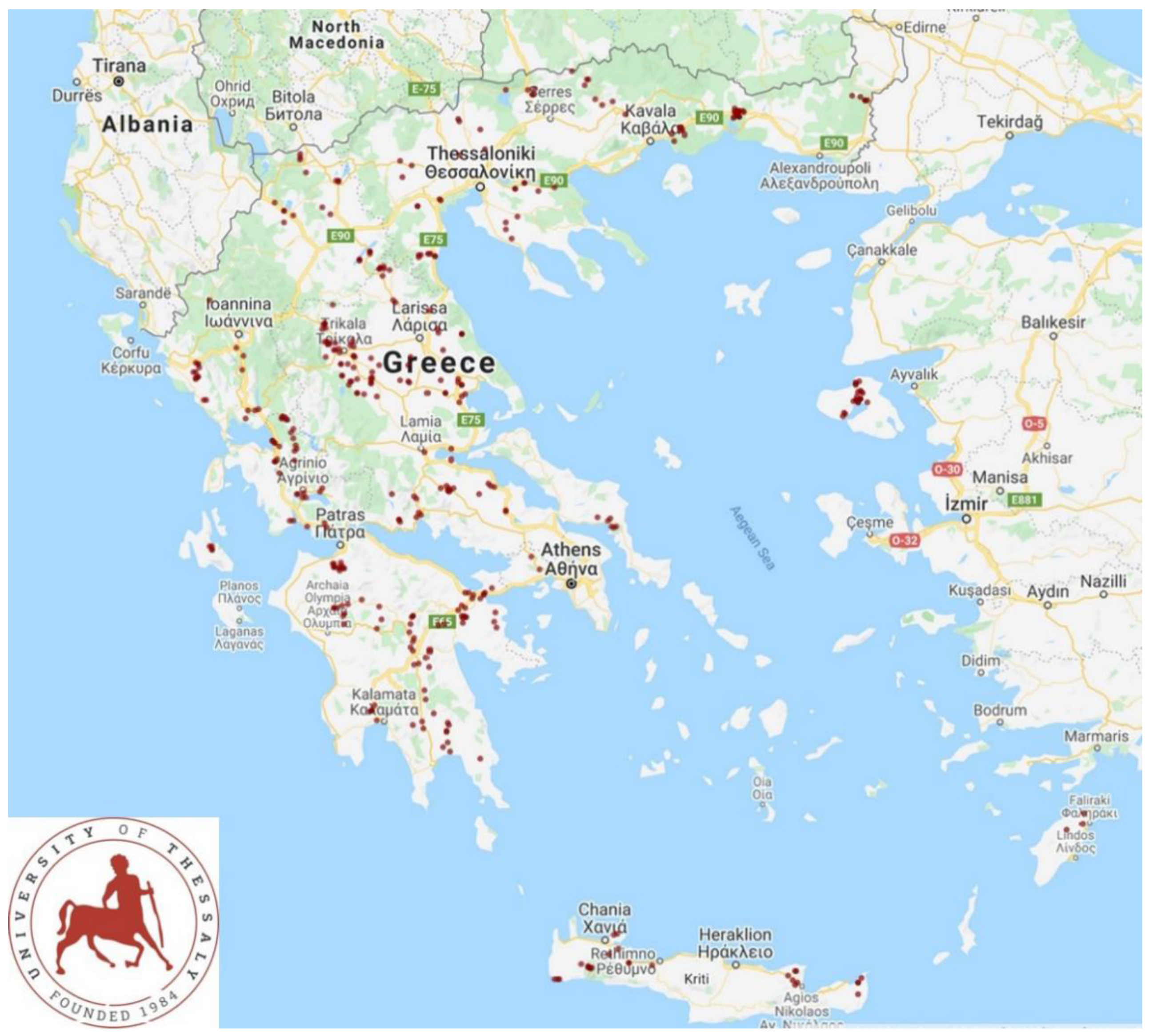
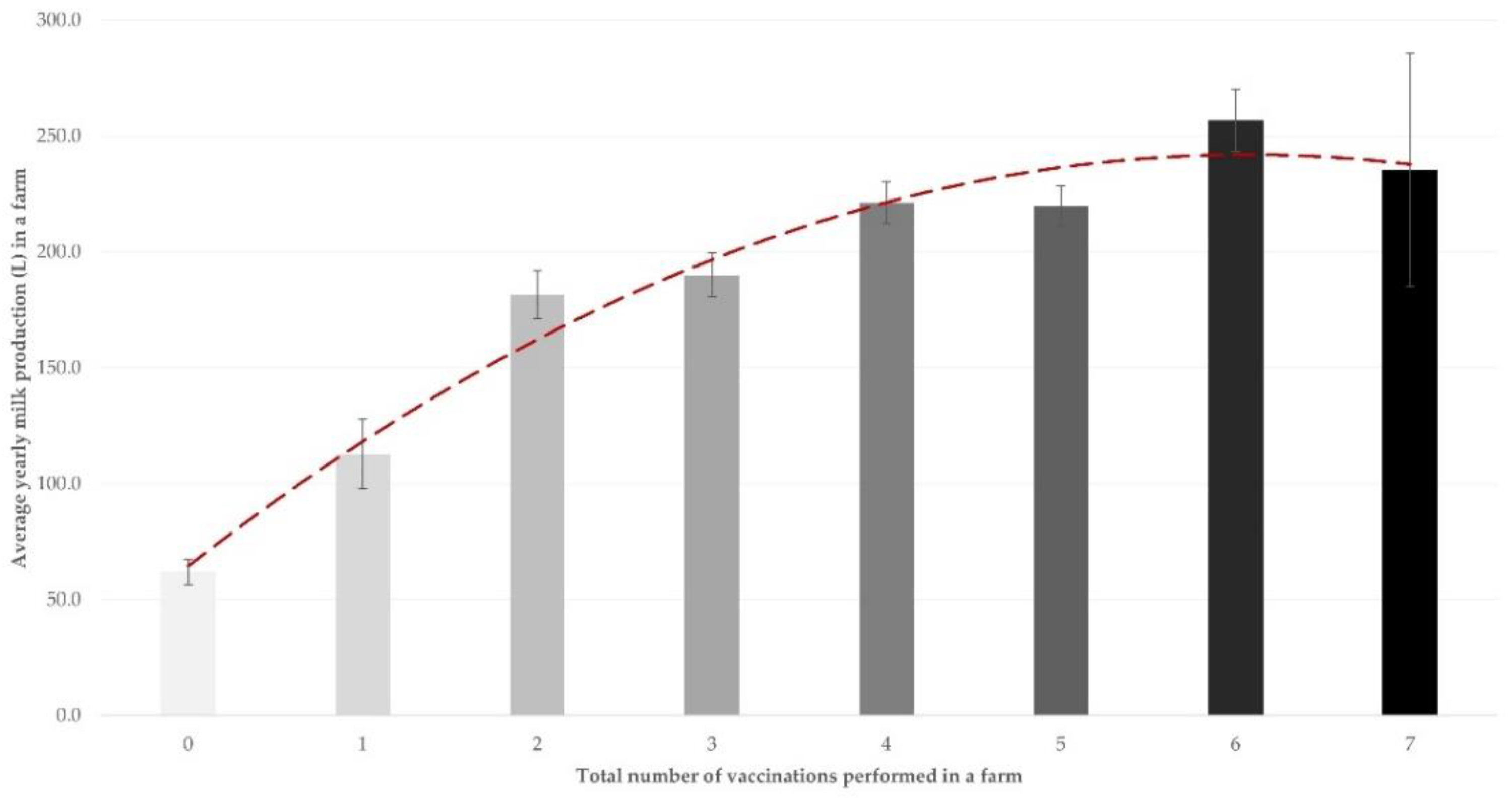
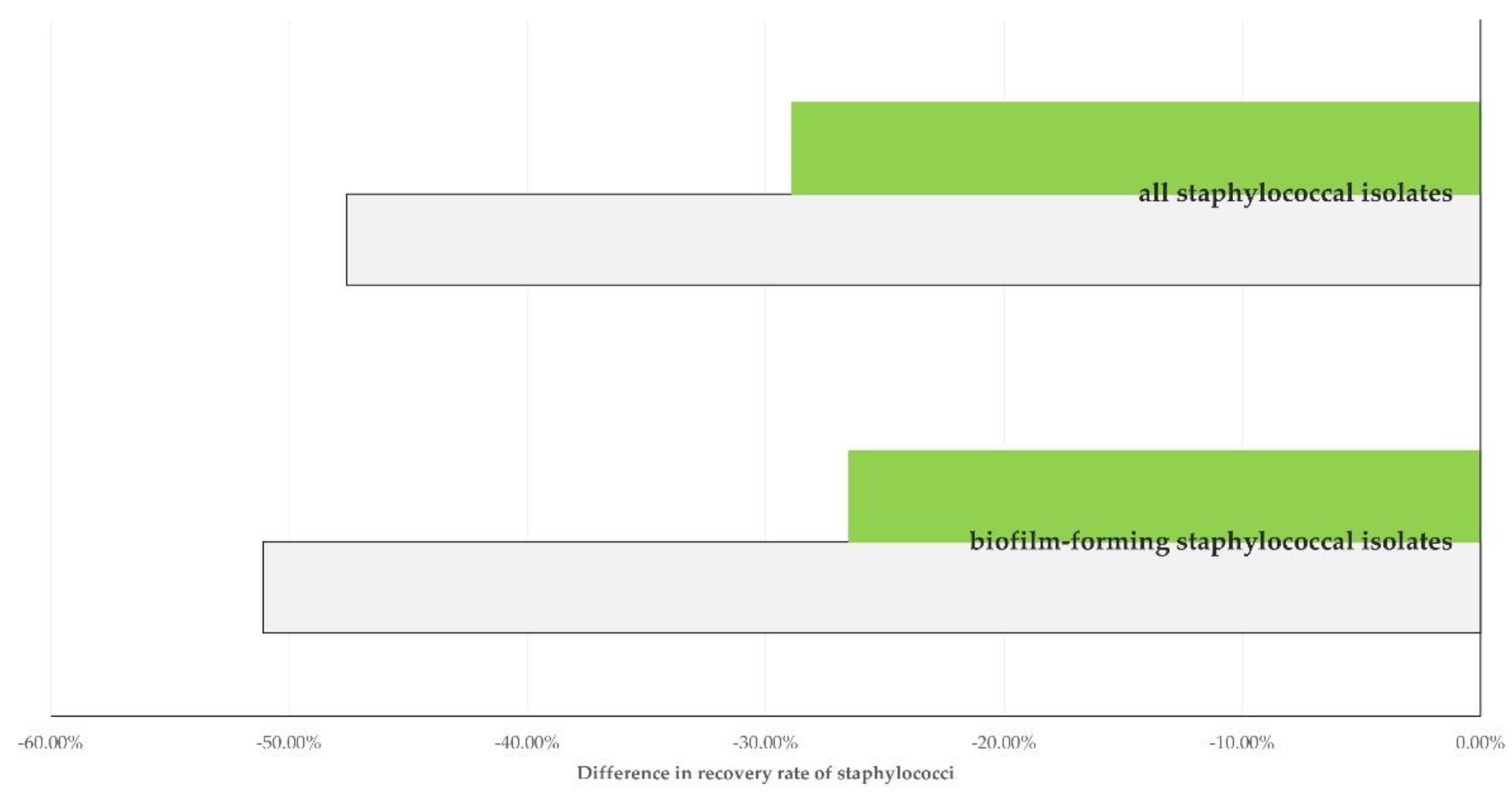
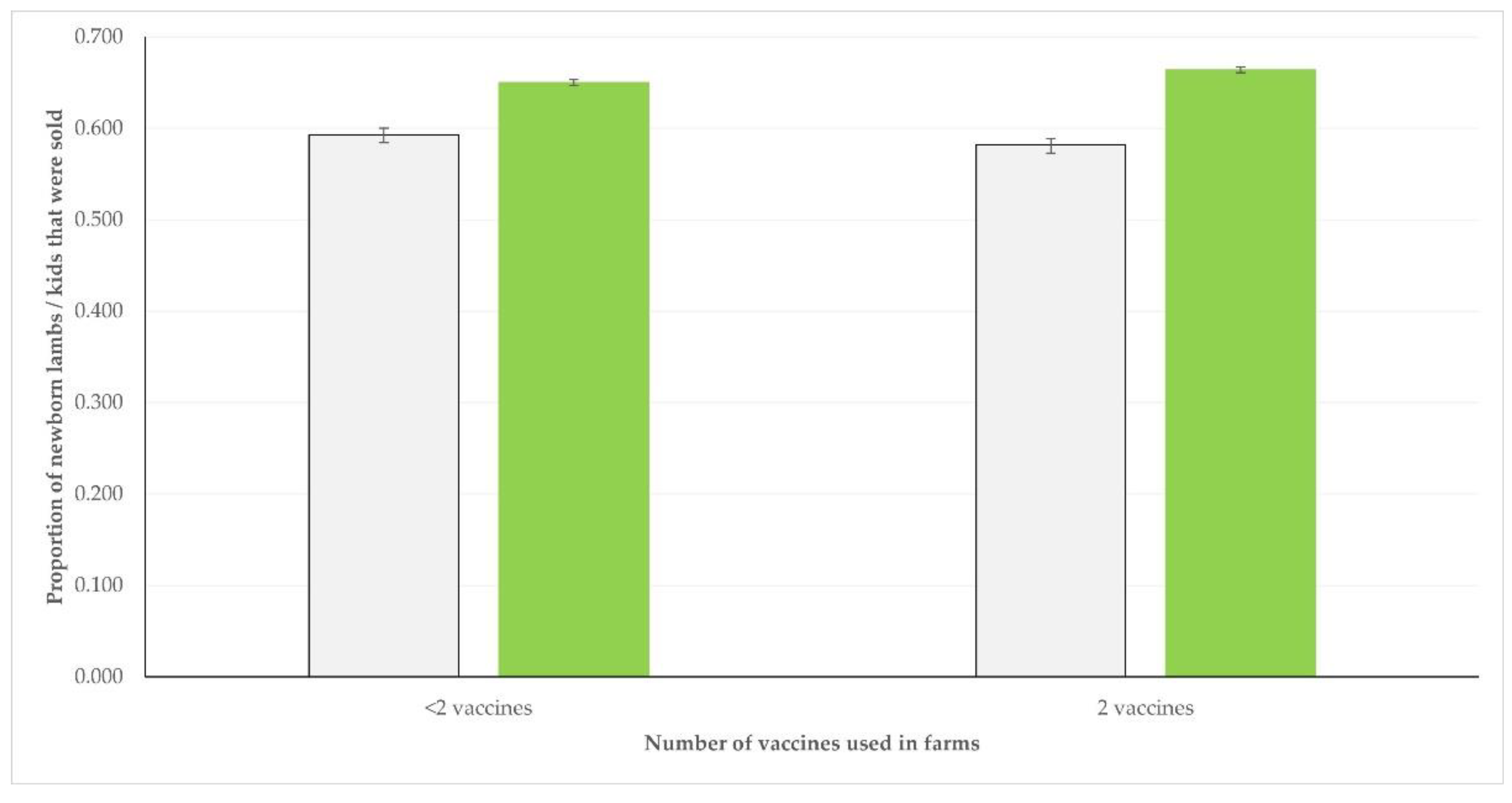
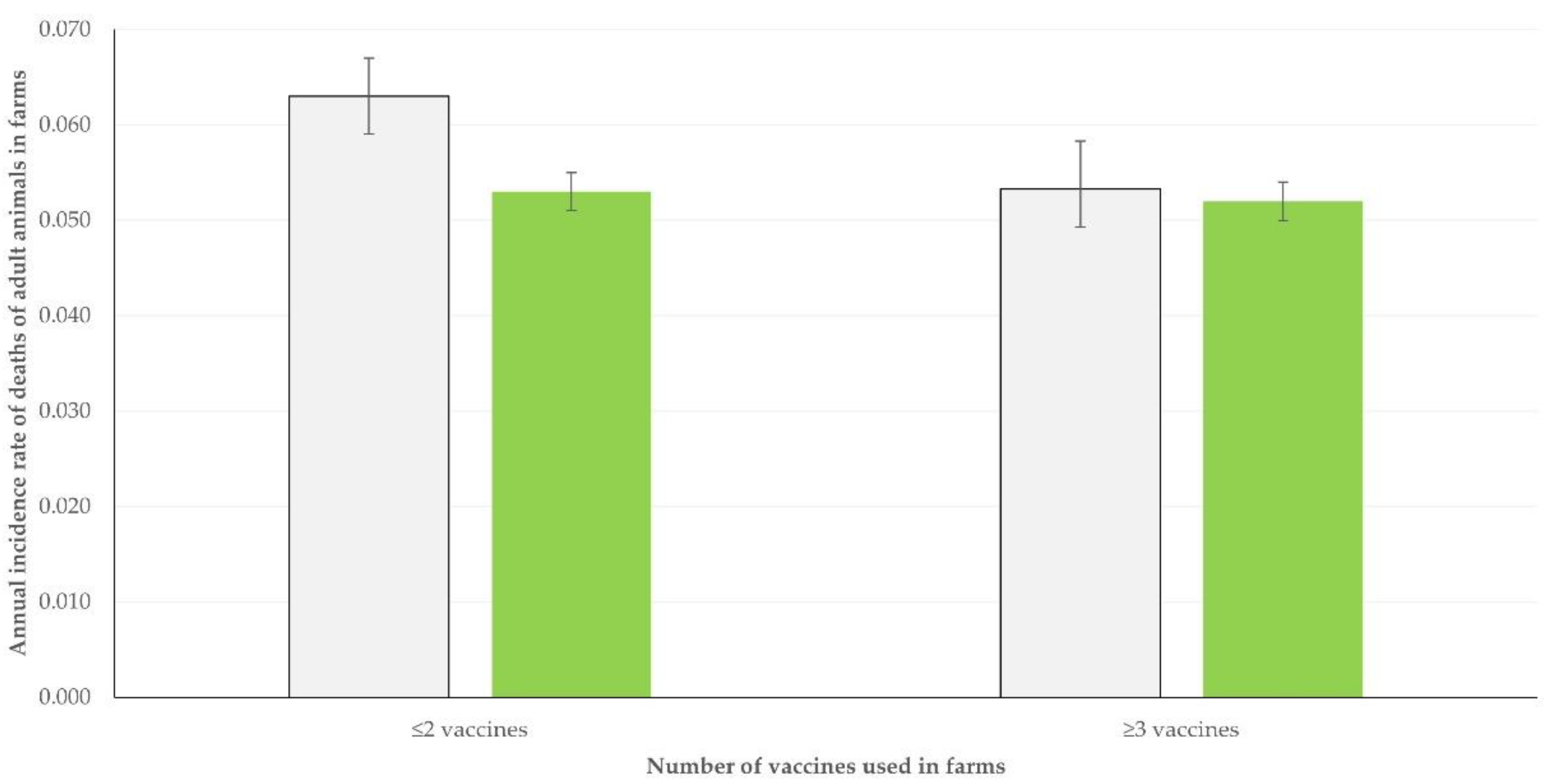
| Infection against Which Vaccinations Were Made | Frequency of Vaccination | ||
|---|---|---|---|
| Sheep Flocks (n = 325) | Goat Herds (n = 119) | p | |
| Brucellosis 1 | 301 (100% (98.7–100%)) | 106 (100% (96.5–100%)) | - |
| Chlamydial abortion | 130 (40.0% (34.8–45.4%)) | 39 (32.8% (25.0–41.6%)) | 0.16 |
| Clostridial infections | 316 (97.2% (94.8–98.5%)) | 118 (99.2% (95.4–99.9%)) | 0.23 |
| Contagious agalactia | 186 (57.2% (51.8–62.5%)) | 65 (54.6% (45.7–63.3%)) | 0.62 |
| Contagious ecthyma | 3 (0.9% (0.3–2.7%)) | 1 (0.8% (0.2–4.6%)) | 0.93 |
| Foot-rot | 5 (1.5% (0.7–3.6%)) | 0 (0.0% (0.0–3.1%)) | 0.17 |
| Paratuberculosis | 11 (3.4% (1.9% 6.0%)) | 31 (26.1% (19.0–34.6%)) | <0.0001 |
| Pneumonia | 144 (44.3% (39.0–49.8%)) | 39 (32.8% (25.0–41.6%)) | 0.028 |
| Staphylococcal mastitis | 126 (38.8% (33.6–44.2%)) | 34 (28.6% (22.0–37.3%)) | 0.047 |
| T. gondii abortion | 0 (0.0% (0.0–1.2%)) | 0 (0.0% (0.0–3.1%)) | n/a 2 |
| Infection against Which Vaccinations Were Made | Frequency of Vaccination | |
|---|---|---|
| Sheep Flocks | Goat Herds | |
| Brucellosis | Use in females kept for replacement (n = 301, 100% 1) | Use in females kept for replacement (n = 106, 100%) |
| Clostridial infections | Use in pregnant females one month before expected start of lambing season (n = 275, 91.4%) or one month before expected start of lambing season and six months thereafter (n = 12, 4.0%) | Use in pregnant females one month before expected start of kidding season (n = 105, 91.3%) or one month before expected start of kidding season and six months thereafter (n = 6, 5.2%) |
| Contagious agalactia | Use in pregnant females three months before expected start of lambing season (n = 38, 82.6%) or one week before expected lambing (n = 4, 8.7%) or twice during gestation 2–3 months apart (n = 4, 8.7%) | Use in pregnant females three months before expected start of kidding season (n = 18, 99.0%) |
| Staphylococcal mastitis | Use in pregnant females during gestation (n = 103, 100%) | Use in pregnant females during gestation (n = 31, 100%) |
| Vaccination Applied | Sheep Flocks | Goat Herds |
|---|---|---|
| No vaccination applied | 166 ± 7 1 L (n = 104) | 170 ± 18 L (n = 45) |
| Vaccination applied against contagious agalactia or staphylococcal mastitis | 221 ± 8 L (n = 130) | 216 ± 15 L (n = 49) |
| Vaccination applied against both contagious agalactia and staphylococcal mastitis | 236 ± 9 L (n = 91) | 226 ± 25 L (n = 25) |
| p | < 0.0001 | 0.08 |
| Outcome | Farm | Variable | p Value |
|---|---|---|---|
| Vaccination against chlamydial abortion | S 1 | Daily number of milking sessions | 0.002 |
| Age of newborns when taken away from dam | 0.003 | ||
| G 1 | Average age of culling female animals | 0.001 | |
| Period spent daily by farmer at the farm premises | 0.002 | ||
| Daily number of milking sessions | 0.031 | ||
| Breed of animals in the farm | 0.032 | ||
| Age of newborns when taken away from dam | 0.037 | ||
| Vaccination against clostridial infections | S | Management system applied in the farm | 0.003 |
| Family tradition in farming | 0.006 | ||
| Age of farmers | 0.024 | ||
| G | Family tradition in farming | 0.006 | |
| Vaccination against contagious agalactia | S | Management system applied in the farm | 0.0002 |
| Duration of dry period | 0.002 | ||
| Collaboration with a veterinarian | 0.013 | ||
| G | Use of laboratory diagnostic examinations in milk samples | 0.002 | |
| Collaboration with a veterinarian | 0.020 | ||
| Vaccination against contagious ecthyma | S | Average age of culling female animals | 0.041 |
| Farmer’s general education | 0.047 | ||
| G | No variables found with a significant association | ||
| Vaccination against foot-rot | S | Farmer’s general education | 0.008 |
| Vaccination against paratuberculosis | S | No variables found with a significant association | |
| G | No. of female animals in the farm | 0.009 | |
| Vaccination against pneumonia | S | Routine administration of antibiotics to newborns | 0.010 |
| Period spent daily by farmer at the farm premises | 0.017 | ||
| G | No variables found with a significant association | ||
| Vaccination against staphylococcal mastitis | S | Use of laboratory diagnostic examinations in milk samples | 0.005 |
| Collaboration with a veterinarian | 0.025 | ||
| Vaccination against staphylococcal mastitis | G | Type of milking mode | 0.002 |
| Daily period spent by farmer at the farm | 0.006 | ||
| Daily number of milking sessions | 0.016 | ||
| Variables | Regression Coefficients (± Standard Error) |
|---|---|
| Sheep flocks | |
| Age of farmers (p = 0.003) | |
| per unit change | –0.10 ± 0.01 |
| Management system applied in farms (p = 0.005) | |
| Intensive | 0.77 ± 0.09 |
| Semi-intensive | reference |
| Semi-extensive | –0.77 ± 0.09 |
| Extensive | –1.54 ± 0.18 |
| Daily number of milking sessions (p = 0.007) | |
| per unit change | –1.58 ± 0.17 |
| Age of newborns when taken away from dam (p = 0.008) | |
| per unit change | –0.09 ± 0.01 |
| Use of laboratory diagnostic examinations in milk samples (p = 0.015) | |
| Yes | reference- |
| No | 1.50 ± 0.17 |
| Collaboration with a veterinarian (p = 0.025) | |
| Yes | reference- |
| No | –0.64 ± 0.20 |
| Routine administration of antibiotics to newborns (p = 0.031) | |
| Yes | reference- |
| No | –0.70 ± 0.16 |
| Goat herds | |
| Daily period spent by farmer at the farm (p = 0.036) | |
| per unit change | 1.07 ± 1.03 |
| Type of Breed of Animals in Farms | Sheep Flocks | Goat Herds |
|---|---|---|
| Crossbreeds | 2.70 ± 0.19 1 (n = 43) | 3.11 ± 0.29 (n = 18) |
| Imported breeds | 3.14 ± 0.10 (n = 139) | 3.13 ± 0.209 (n = 45) |
| Local breeds | 2.59 ± 0.12 (n = 143) | 2.36 ± 0.18 (n = 56) |
| p | 0.002 | 0.008 |
Publisher’s Note: MDPI stays neutral with regard to jurisdictional claims in published maps and institutional affiliations. |
© 2022 by the authors. Licensee MDPI, Basel, Switzerland. This article is an open access article distributed under the terms and conditions of the Creative Commons Attribution (CC BY) license (https://creativecommons.org/licenses/by/4.0/).
Share and Cite
Lianou, D.T.; Michael, C.K.; Petinaki, E.; Mavrogianni, V.S.; Fthenakis, G.C. Administration of Vaccines in Dairy Sheep and Goat Farms: Patterns of Vaccination, Associations with Health and Production Parameters, Predictors. Vaccines 2022, 10, 1372. https://doi.org/10.3390/vaccines10091372
Lianou DT, Michael CK, Petinaki E, Mavrogianni VS, Fthenakis GC. Administration of Vaccines in Dairy Sheep and Goat Farms: Patterns of Vaccination, Associations with Health and Production Parameters, Predictors. Vaccines. 2022; 10(9):1372. https://doi.org/10.3390/vaccines10091372
Chicago/Turabian StyleLianou, Daphne T., Charalambia K. Michael, Efthymia Petinaki, Vasia S. Mavrogianni, and George C. Fthenakis. 2022. "Administration of Vaccines in Dairy Sheep and Goat Farms: Patterns of Vaccination, Associations with Health and Production Parameters, Predictors" Vaccines 10, no. 9: 1372. https://doi.org/10.3390/vaccines10091372
APA StyleLianou, D. T., Michael, C. K., Petinaki, E., Mavrogianni, V. S., & Fthenakis, G. C. (2022). Administration of Vaccines in Dairy Sheep and Goat Farms: Patterns of Vaccination, Associations with Health and Production Parameters, Predictors. Vaccines, 10(9), 1372. https://doi.org/10.3390/vaccines10091372








